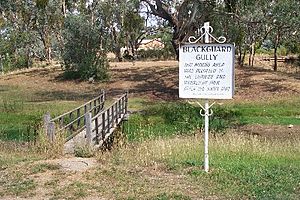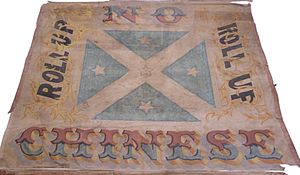Blackguard Gully facts for kids
Quick facts for kids Blackguard Gully |
|
|---|---|

Blackguard Gully Reserve and sign
|
|
| Location | Whiteman Avenue, Young, Hilltops Council, New South Wales, Australia |
| Built | 1860–1861 |
| Owner | Hilltops Council |
| Official name: Blackguard Gully; Lambing Flat gold fields; Burrangong goldfields | |
| Type | State heritage (archaeological-terrestrial) |
| Designated | 13 March 2009 |
| Reference no. | 1775 |
| Type | Massacre/battle site |
| Category | Exploration, Survey and Events |
| Lua error in Module:Location_map at line 420: attempt to index field 'wikibase' (a nil value). | |
Blackguard Gully is a special historical place in Young, Australia. It used to be a mining camp for Chinese gold miners. Today, it is a reserve.
This area was part of the famous Lambing Flat goldfields. It was also a main spot for the Lambing Flat riots in 1861. These riots were a series of protests against Chinese miners. The Hilltops Council now owns and looks after Blackguard Gully. It was added to the New South Wales State Heritage Register in 2009. This means it is a very important historical site.
Contents
History of Blackguard Gully
The land where Young is located today once belonged to the Indigenous Wiradjuri people. They did not often camp here because there was not always enough water. However, they would travel through the area.
In 1826, a man named James White settled in the area. He set up a sheep farm. He called one part "Lambing Flat" because it was a sheltered valley where ewes (female sheep) gave birth to lambs. In March 1860, gold was found along the creek by White's nephew, Dennis Rogan, and another miner.
The Lambing Flat Riots
Within six months, many miners arrived. About 1,200 Europeans and 500 Chinese came to work in the area. This led to the town of Young being formed. Many European miners did not find much gold. This made them upset with the Chinese miners.
On 13 November 1860, about 500 Chinese miners were forced to leave their camp. Their tents were burned, and their mining spots were taken.
On 12 December 1860, miners tried to drive the Chinese away again. Reports said two Chinese miners were hurt when their traditional hairstyles (pigtails) were cut off. This news worried people in Sydney. The government sent police to the goldfields. Even with police there, more trouble started in January 1861. European miners gathered and forced about 200 Chinese miners out of Blackguard Gully.
After this, police arrested 11 men for burning tents. However, many European miners gathered and demanded their release. The next day, the men were let go due to a lack of clear evidence. This led to more problems, and Chinese people were kept out of town to prevent more violence.
By February 1861, new gold discoveries brought even more people. There were over 12,000 Europeans and 2,000 Chinese miners. The government sent more police and soldiers to the area in May 1861. They set up a camp with guns to keep order.
On 2 March 1861, the leader of New South Wales, Premier Charles Cowper, visited Young. After his visit, Chinese miners were mostly limited to Blackguard Gully. This was because the government had difficulty passing laws to protect them.
Miners formed a group called the Miners' Protective League. They wanted to remove the Chinese miners. They claimed the Chinese used too much water, which was very valuable. Premier Cowper met with miners. He said the government wanted to limit Chinese miners. But he also said they must not be harmed. He explained that Britain had a treaty with China that allowed Chinese people into British lands.
The soldiers were a common sight. But when they left in May 1861, fears of more riots grew. Chinese miners started to return. In June, news spread that 1,500 more Chinese were coming. This made the European miners angry again.
On 30 June 1861, about 3,000 European miners gathered. They marched to Blackguard Gully and Back Creek. They carried a flag that said "Roll-up, Roll-up, No Chinese". They burned tents and belongings of the Chinese miners. They also cut off their pigtails and forced them out of their camps.
What Happened Next
The Chinese miners found safety with the Gold Commissioner. They later asked for money for their losses. They claimed over £40,000, but the government paid about £4,240 for some of the losses. After the riots, the government passed a law to limit Chinese people coming to Australia. Similar laws were made across Australia in 1880 and 1881.
On 14 July 1861, the "Riot Act" was officially read to the miners. This was the only time this act was officially read in New South Wales history. The goldfields were very rich, sending out a lot of gold.
In 1861, Lambing Flat was renamed Young. This was to honour Sir John Young, who was the Governor of New South Wales. When the gold ran out, most miners left. Farmers and businesses took their place. Some Chinese migrants stayed in Young and helped with these new activities.
Today, Young remembers its history. During the Lambing Flat Festival in April, people re-enact the "Roll Up" march and the reading of the Riot Act. A painting of the miners and the original "Roll Up" flag are on display at the Lambing Flat Folk Museum.
Blackguard Gully Today
Blackguard Gully is now a reserve with open grassland and trees. A creek runs through it, crossed by a simple wooden bridge. A sign in the reserve says: "BLACKGUARD GULLY. THIS MINING AREA WAS ALLOTED TO THE CHINESE AND WORKED BY THEM AFTER THE RIOTS 1861."
Experts believe there might still be some old items buried in the ground. These could tell us more about how the site was used in the 1860s. Keeping Blackguard Gully as a reserve helps us understand its history. We can see how it was used by Chinese miners and how far the European miners marched during the riots.
Why Blackguard Gully is Important
Blackguard Gully is very important historically. It was the site of some of the worst riots against Chinese miners in Australia. The events of 1861, including the march of 3,000 Europeans and the "Roll-up, Roll-up, No Chinese" flag, are a significant part of Australia's past. This flag is now in a museum.
These riots led to new laws that limited who could mine for gold and who could come to Australia. The march and the reading of the Riot Act were very important for the history of Young.
Blackguard Gully is linked to the Chinese miners who lived and worked there in the 1860s. The town of Young still remembers these events today. The Lambing Flat Festival re-enacts the "Roll Up" and the reading of the Riot Act.
The site might still hold archaeological clues from the 1860s. While many goldfields had protests against Chinese miners, Lambing Flat was special. The riots were very organised, they had a unique flag, and the riot site (Blackguard Gully) is still a public space today.
Blackguard Gully is important because:
- It shows a key event in New South Wales history: the riots against Chinese miners.
- It is connected to the Chinese miners who worked at Lambing Flat.
- It is culturally important to the people of Young and New South Wales.
- It has the potential to reveal more about the past through archaeology.
- It is a rare example of a riot site that is still a public space.
- It represents a typical mining site from the 1860s in Australia.


